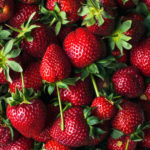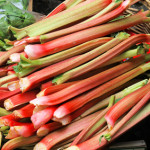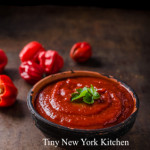Though they are available year-round in grocery stores the best strawberries are to be found in farmer’s markets in spring and early summer.
Look for smaller berries, preferably organic ones, with a rich, glossy red color and shiny green leaves. Avoid berries with white or green shoulders and brown or limp leaves. Never buy them if they are moist, overly soft or show signs of mold. Do not buy berries if their cartons are leaking and wet, a sure sign that unseen fruits will be moldy.
Although fresh strawberries should be rinsed, do not soak them for any length of time since they will absorb the water and turns mushy. For eating on their own, strawberries, even very large ones, should be left whole. Hull strawberries before freezing them or using them for most preparations. Use a small paring knife or a strawberry huller to carve out the white center core from the stem end of each berry. To improve the flavor of lackluster strawberries, hull and slice them, place in a bowl and sprinkle with a tablespoon or two of sugar for every pint. Let stand at room temperature for at least 15 minutes. The sugar draws moisture from the berries to make a sweet natural syrup.
Fresh strawberries are fragile so handle them with care. Don’t wash the berries until just before you are ready to eat them, as the moisture will encourage mold. To store strawberries, line a glass or plastic container with paper towels, carefully arrange the berries inside and cover with the lid. They will keep in the refrigerator for up to 1 week.
©Tiny New York Kitchen © 2021 All Rights Reserved
Roasting refers to proteins and vegetables cooked mostly at high temperatures in the oven. Baking uses a lower temperature to cook breads, baked goods, and casseroles.
Roasting makes any vegetable taste better. It brings out their flavor, caramelizes their natural sugars, and adds crunch. If your family doesn’t love certain vegetables like broccoli or Brussels sprouts, roasting is a great way to change their mind. Double what you’re roasting and then turn extra servings into quick meals later in the week. Cooking a little extra with one meal lets you make the most of value-sized packages of proteins and other store sales. With leftover already planned, you won’t need to lean on takeout.
Why we love to roast:
It’s Affordable! Inexpensive ingredients are tastiest when roasted. Root vegetables are browned and crisp, tomatoes and grapes are extra juicy and sweet, and tough cuts of beef are fall-apart tender. You also don’t need any special equipment to roast.
Roasting Is Healthful! Roasted foods need very little fat to cook compared to frying or sautéing. Roasting also intensifies flavors without added salt, sugar, or other ingredients.
It’s Easy! Roasted foods need little prep before they cook. And once the oven door closes, you can walk away. Fewer pans and utensils are needed, making cleanup easier too.
Essential Tools For Roasting:
Rimmed Sheet Pan: The rim keeps vegetables from falling off the sides and catches any juices from meats and fish.
Oven-Save Skillet: Go from stovetop to oven and back. Sear meats before roasting or make a pan sauce with the meat drippings after roasting.
Roasting Pan: Best for large roasts, hams, and turkeys. An inner rack lifts the meat so it can brown and crisp underneath.
Parchment Paper: Line pans to keep foods from burning and sticking, then toss for easy cleanup. If roasting at a higher temp or broiling use foil.
Metal Tongs: Flip and stir foods on a hot pan with ease. Look for tongs with a heat resistant grip.
Silicone Brush: Brush on a sticky glaze or baste foods with sauce. The silicone bristles are easy to clean.
Tips For Sheet Pan Roasting:
Jump Start Browning by preheating your sheet pan before adding vegetables.
Pat foods very dry with paper towels so the outside browns while the inside cooks through.
Cut foods to the same size and thickness so smaller pieces don’t burn.
Space out foods on the sheet pan so they have room to crisp and brown.
Let sheet pans cool before rinsing to keep the metal from warping.
©Tiny New York Kitchen © 2021 All Rights Reserved
Kick up popcorn’s flavor with easy and creative combinations.
ITALIAN STYLE
Toss popcorn with finely grated Parmesan, a sprinkling of Italian seasoning, and red pepper flakes.
SAVORY SESAME
Drizzle lightly buttered popcorn with a small amount of sesame oil, then sprinkle with sesame seeds, and crushed seaweed snacks.
CRABBY CORN
Sprinkle buttered popcorn with Old Bay seasoning, kosher salt, and a small pinch of cayenne.
TEX MEX
Toss buttered popcorn with taco seasoning, garlic powder, and a pinch of chipotle chili powder.
CINNAMON SUGAR
Toss hot popcorn in cinnamon sugar immediately after popping to create a kettle corn-like crunch. Or combine sugar with a small pinch of pumpkin pie spice and toss for pumpkin kettle corn.
ALMOND JOY
Toss popcorn with mini chocolate chips, coconut flakes, and chopped roasted almonds.
SALTED CARAMEL
Sprinkle hot buttered popcorn with turbinado sugar, crushed hard caramel candies, and sea salt.
“Work With What You Got!”
©Tiny New York Kitchen © 2020 All Rights Reserved
Start small, with goals that work for you and your family. These are the habits you’ll keep in the long run.
1. Add More Color To Your Plate
More color on your plate means more variety, more nutrients, and more flavor. The next time you shop, try putting the rainbow in your cart: orange citrus, yellow pineapple, and dark leafy greens.
2. Eat Seasonally
Keep a produce calendar handy so you know what to look for. In season produce is fresher and typically less expensive. January is good for root vegetables, kale, and citrus.
3. Drink More Water
Stay hydrated by infusing your water with citrus slices, herbs, berries, or cucumber. Making water more interesting will encourage you to drink more.
4. Try A Whole Grain Swap For Pasta And Bread
Once in a while replace regular pasta and bread with a whole grain alternative. These complex carbs will help you feel full. Look for whole wheat, whole grain, and multigrain alternatives.
5. Pack Your Snacks
Opt for high fiber and protein snacks like hummus and pretzels or apples and peanut butter. Unlike sugar and empty carbs, fiber ad protein will keep you full.
6. Eat Breakfast More Often
Stock up on on-the-go options. Egg muffins in the freezer, instant oatmeal in the pantry, and a bowl of fruit on the counter. The morning rush won’t be an excuse for skipping this important meal.
7. Make A Shopping List
Check your refrigerator, freezer, and pantry before making a list. Organize your list based on the layout of your store. You’ll save time at the store and won’t accidently buy what you already have.
8. Try A Plant-Based Swap For Meat
Try a meatless version of a weeknight staple like burgers, pizza, or pasta. You’ll get more nutrients into your meals by swapping meat for plant-based options.
9. Stock Your Freezer
Keep staples like frozen meatballs or chicken tenders and steam-in-bag vegetables for last minute meals. A fully stocked freezer is better than takeout. You’ll save money and get dinner on the table even on busy weeknights.
10. Reduce Your Food Waste
Use overripe fruit in smoothies and muffins. Turn leftover vegetables into stir fries and soups. Turning leftover produce into nutrient-dense meals is a win-win for your wallet and your health.
11. Make A Meal Plan
Write meals on the calendar at the start of the week. Everyone knows the menu and you won’t be scrambling for dinner ideas at 5pm.
12. Bring Your Lunch 3 Days Per Week
Instead of swearing off midday takeout, start with 3 days a week. When you pack school lunches, pack office lunches too. You’ll save time waiting in line, save money, and eat better.
13. Try A New Recipe
Shake up your dinner routine with a recipe or ingredient you haven’t use before. You’ll avoid a recipe rut and learn new kitchen skills.
14. Eat Out One Less Time Each Week
Try a speedy dinner or slow cooker meal that’s ready when you get home. Home cooked meals allow you to control the ingredients and choose more healthful options.
15. Drink Less Soda
Swap for flavored seltzer, iced tea, or sparkling fruit juice. Instead of cutting out soda try drinking 1 less can a day. Quitting cold turkey makes habits hard to break. Start with a smaller goal and eventually it will make a big difference.
16. Eat Together One More Night Each Week
Make dinner device-free, with everyone eating together. Keep it fun with a top-your-own taco, baked potato, or burger night. Enjoying a meal together as a family has been shown to encourage healthy eating habits and better communication.
17. Cook With Your Children Once A Week
Children who help choose, shop for, and prepare a recipe will be more interested in eating it.
18. Get Ahead On Sunday
Prep components instead of entire meals. Roast vegetables, cook grains, and bake extra chicken, then mix and match for quick lunches and dinners during the week. Planning ahead helps you save time, eat better, and reduce the stress of busy weeks.
19. Embrace Healthy Fats
Look for sources of unsaturated fats, like olive oil, nuts, seeds, and avocados. Good-for-you fats help regulate cholesterol, absorb vitamins, and prevent heart disease.
20. Give Plants More Plate Real Estate
Fill about half of your dinner plate with plants, then divide the rest between your starch and protein. Rebalancing your plate is an easy way to eat healthfully.
“Work With What You Got!”
©Tiny New York Kitchen © 2019 All Rights Reserved
Fire things up with popular hot sauces. Whether you’re just starting to heat things up or you’re looking for new options there’s a sauce to spice up any meal.
HARISSA
This thick North African sauce combines hot peppers with garlic and other seasonings. It’s traditionally served with couscous, but harissa can also add flavor and fire to everything from meat and fish to vegetables and eggs.
SRIRACHA
While there is sriracha from Thailand (it’s named after the town where it was created in the 1930s), the wildly popular one used in everything from wings to Bloody Marys is produced in Southern California. Both feature fresh red chilies, sugar, salt, garlic, and vinegar.
GREEN HOT SAUCE
Most hot sauces are red because they’re made with red peppers, but there are green versions, which are typically made with jalapeños and/or poblanos and sometimes tomatillos. Green sauces can be milder or more herbal, but heat levels vary from sauce to sauce.
LOUISIANA STYLE
Most hot sauces are based on the Louisiana style formula of chilies, vinegar, and salt, and puréed into a thin red liquid. Which peppers are used, how they’re processed, and additional ingredients make for endless variety.
MEXICAN HOT SAUCE
South-of-the-border sauces tend to use the same Louisiana style combination of chilies, vinegar, and salt, and have a similar flavor, but if you’re eating tacos, why not reach for a bottle from Mexico? Many include chipotles, which are dried and smoked jalapeños, and add smoky flavor.
“Work With What You Got!”
©Tiny New York Kitchen © 2019 All Rights Reserved
Juicy berries are bursting with flavor and now is the perfect time to pick them up, whether for snacking or adding to sweet and savory recipes.
Make sure to look for bright, shiny strawberries, and skip any that are smashed, shriveled, or moldy. Their color should be deep and even, with no white or green patches, and they should smell fragrant.
Wait to wash them. Water increases the risk of mold, so leave berries in their original packaging and rinse in cold running water just before serving. Their shelf life is short, so serve or cook berries within 2 to 3 days.
Despite their sweetness, strawberries are relatively low in sugar. They also provide fiber, antioxidants, and vitamin C. In fact, strawberries contain more vitamin C per serving than oranges!
“Work With What You Got!”
©Tiny New York Kitchen © 2019 All Rights Reserved
Nothing compares to crisp and juicy in-season apples, and now is the perfect time to make the most of them in both sweet and savory dishes.
Pick Like A Pro
When shopping, avoid apples with nicks, bruises, or soft spots and seek out fruit that’s firm and heavy for its size. Make sure the skin is smooth and shiny, as dull skin is often a sign that apples are lacking in taste and texture.
Keep Cold
Apples lose their crispness at room temperature, so be sure to store them in the refrigerator, where they’ll keep for up to three weeks. Separate soft or bruised apples, which can cause perfectly good ones to soften more quickly.
Know The Benefits
Apples are more than just a low-calorie snack. They’re also packed with fiber, which has been shown to reduce the risk of some cancers, as well as heart disease. Plus, fiber keeps tummies feeling full, so you’re less apt to reach for sugary treats.
Apples Love Lemons
A squeeze of lemon juice helps keep cut-up apples from browning.
www.tinynewyorkkitchen.com
“Work With What You Got!”
©Tiny New York Kitchen © 2018 All Rights Reserved















